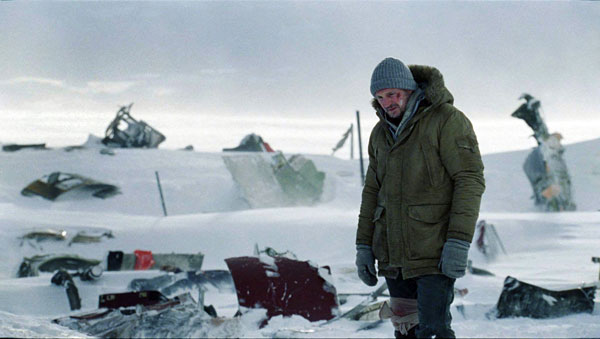
Written by Joe Carnahan and Ian Mackenzie Jeffers
Directed by Joe Carnahan
USA, 2012
Man vs. nature may be a narrative as old as time, but Joe Carnahan’s The Grey would probably have been most at home in the 1970s. Clocking in at a hefty, patient 117 minutes, boasting as bare-bones a plot as a mainstream feature possibly can, and with a minimum of dramatic showboating or audience-friendly dramatic signposting. The Grey is pleasantly and excitingly out of time.
Liam Neeson, who previously starred in Carnahan’s version of The A-Team, stars here in a very different capacity as Ottway, a sadly adrift figure working in self-exile, as a wolf hunter for an oil company in Alaska. Since the death of his wife, he is entirely without purpose, even entertaining notions of suicide. He doesn’t get that far, though, as his routine is cut short when he and an assorted band of industry workers find themselves utterly stranded in the frigid wilderness following a plane crash. Seven, including Ottway, remain alive once the debris is cleared, but the real threat to their survival is two-fold: the weather itself, unforgiving and unrelenting; and the taunting, almost spectral presence of a roving pack of timber wolves.
Where The Grey diverges from survival thrillers past is in its pronounced existentialist streak. Ottway and his fellow survivors (including Dermot Mulroney and Dallas Roberts) struggle with individual crises of faith (or lack thereof) while simultaneously battling the elements and their own failing bodies. Carnahan keeps a close watch of the film’s tone and intensity level throughout; long periods of pensive observation actually serve to ratchet up the tension, since the creatures have a tendency to emerge suddenly and viciously. What’s more, the more philosophically inclined portions of the film rarely feel heavy-handed or too highfalutin’ for the surrounding chaos; Carnahan and Ian Mackenzie Jeffers’ carefully calibrated screenplay only throws out enough of these moments to lend a pleasing ambiguity to Ottway’s journey, making sure that the film works equally well as straight-up thrill ride as well as allegorically loaded fiction.
And yes, there actually are thrills to be had, especially in the first 45 minutes or so following the crash; if the sight of the barely-torchlit blackness gleaming with a dozen pairs of fearsome eyes isn’t enough, the near-constant sense of dread generated by the tentativeness of the group’s shelter and the general uncertainty of how to deal with the predators (despite Ottway’s expertise) makes for a genuinely nail-biting run. That tension eases up a bit throughout the second half, both thanks to deliberate slowdown and one cliffside sequence that suffers from less-than-convincing green-screen effects, but rallies admirably in the last reel, which culminates in the gutsiest ending to a Hollywood feature in recent memory.
Where the film’s considerable (by contemporary standards) runtime would normally result in significant pacing issues, the drawn-out feel actually serves the material, so that by the time Ottway and the rest are crossing the umpteenth windswept hellscape, the chill has had time to truly set in. While the film does have a few moments of excess sentimentality (perhaps owing to a few too many shots of Ottway’s departed wife), it still manages to feel like a relic from an era when Hollywood films were allowed to meander and to elide cozy resolutions from time to time.
Simon Howell


